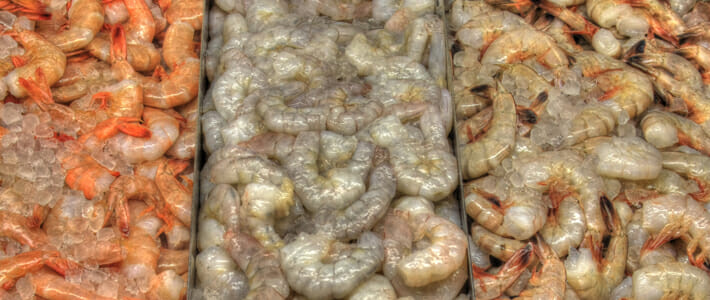Shrimp

While shrimp may be small, they are certainly anything but shrimpy in their appeal. In fact, these deliciously clean and crisp tasting crustaceans are the most popular seafood in the United States, not counting canned tuna fish. The firm, translucent flesh of raw shrimp comes in a wide range of colors depending upon the variety. It can be pink, gray, brownish, or yellow. Once cooked, the flesh of these crustaceans becomes opaque and cream or pinkish in color.
Product pdf for download-
4 oz. (100g) raw edible portion
-
Calories 112.27
-
Calories from Fat 11.02
-
Total Fat 1.22g
-
Saturated Fat 0.33g
-
Cholesterol 221.13mg
-
Sodium 1,118mg
-
Total Carbohydrates 0
-
Protein 23.71g
Texture
Shrimp have firm, translucent flesh.
Color
Variation per species will depend on shrimp shell color as influenced by age (size), harvest season and location, diet, etc. White shrimp come in varying shades of grayish-white and aqua with tints of green, blue, and red. Brown shrimp can be reddish to grey-brown with occasional blue-purple hues. Pink shrimp vary from light to rose pink and can darken to resemble light brown shrimp. Red to rose-colored shells are typical for royal-red shrimp and other deepwater and cold water species. Despite this variation in shell color, the basic entire meat color is white.
Preparation
Shrimp is good almost any way you can think of. It is good by itself, or a wonderful addition to any sauce.
Quality Control
Be aware of shrimp having black spots on their shell as this is often a sign of the meat getting spoiled. Do not buy yellow shrimp. Yellow is no color a shrimp should have and it often indicates that chemicals were applied. Healthy (and tasty!) shrimp should have an aroma of saltwater, a consistant meat and their shell should be intact. Usually it is better not to peel the shrimp before you cook them. The shell itself carries a large part of their specific taste. Yet, if you will serve the shrimp within a soup or another hot liquid it will be the best option. Deveining is mandatory. There is no specific benefit associated to it, neither a harm.
Source
Over 300 different species of shrimp are harvested worldwide, and within these 300 species, thousands of varieties are available. In the United States, the most commonly available type is the deep-water shrimp, which is also referred to as the pink shrimp. It is three to four inches in length and reddish-pink in color. Giant tiger prawns are also becoming popular in the U.S. These large shrimp, measuring six to twelve inches in length, are one of the most widely consumed types in many regions of Asia.
Harvest Method
Shrimp are fished with trawls, which are open mesh nets towed along the bottom of the ocean (seasonal) or they are farmed year-round as an aquaculture business.
Flavor
Flavor and odor are best described as mild and pleasant. Spoiled shrimp begin to emit an ammonia smell. An iodine odor or flavor is common for shrimp and will vary per species and harvest location and season. The iodine does not denote spoilage.
Market Segments
Shrimp are appropriate in the casual dining, fine dining, hotel, and resort/club segments of the market.